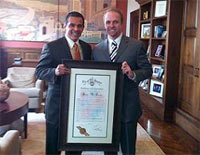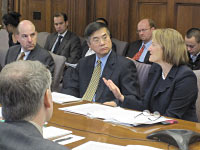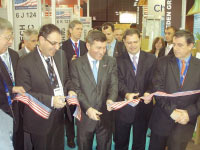Q&A with Brian McGowan, Deputy Assistant Secretary of Commerce for Economic Development

U.S. Deputy Assistant Secretary Brian McGowan leads the White House National Incident Command (NIC) Economic Solutions Team, which is working to help communities and regions mitigate the impacts of the BP Oil Spill. This initiative is part of EDA's goal to support collaborative regional innovation to promote sustainable job growth and strengthen communities that have suffered disproportionate economic and job losses to become more competitive in the global economy.
Q. What was the role of the Economic Solutions Team within the National Incident Command?
A. During the summer 2010, following the Deepwater Horizon oil spill, the Economic Solutions Team worked extensively with Federal interagency partners and affected Gulf Coast communities in considering the economic recovery needs of the region. Many of these initiatives involved extensive coordination and communication of activities between many Federal agencies including the SBA, HUD, USDA, DOL, DHS, White House, DOEd, CNCS, and others. In addition, over several weeks in August 2010, multiple teams comprised of federal agency representatives, economic development organizations and experts in economic development deployed to the Gulf Coast region to conduct a series of economic development needs assessments in 19 counties affected by the oil spill. These trips followed the completion of two "pilot" trips in June and July. This effort was part of the Obama Administration's overall response to the Deepwater Horizon oil spill and was carried out through the National Incident Command.
Q. What was the outcome of the efforts of the 21 economic development and assessment teams?
A. The teams included 125 federal officials partnered with 105 economic development experts, visited five states (Florida, Louisiana, Alabama, Mississippi, and Texas) to conduct 3-day assessments of each region. A total of 672 meetings were held with approximately 1,281 people representing 854 entities. The objective of these qualitative assessments was to provide multi-disciplinary, customized, and capacity-building technical assistance for impacted communities. The assistance was designed to foster each community's ultimate development of its own strategies for economic recovery.
Each site visit was structured to meet with a wide swath of key stakeholders from different sectors of the local community, including economic development leaders, political leaders, local government officials, business owners, workforce intermediaries, educational leaders, financial sector representatives, etc. Based on stakeholder-identified economic development needs, the assessment teams identified potential short- and medium-term strategies for economic recovery that communities could consider.
The findings of the assessment and evaluation teams informed
the development of comprehensive framework for Gulf Coast
recovery provided in Secretary of the Navy Ray Mabus' report,
America's Gulf Coast: A Long Term Recovery Plan After the
Deepwater Horizon Oil Spill ("Mabus Plan"). Specifically,
the teams' findings were instrumental in shaping the economic
section of the report. That report is available here.
Q. What resources are available to impacted communities working through the economic recovery?
A. Each community has unique attributes, assets and recovery/economic development needs. The assessment and evaluation teams worked closely with local stakeholders to understand their individual characteristics and needs. The summary report sent to each community reflects an analysis of the county/parish's specific assets, economic development resources, and key recovery areas.
Recovery Resources
A guide has been compiled with best-practices that can be adapted for implementation in many communities. These resources can be found at the following links.
- An overview of the assessment and evaluation team process with a guide to common best practices on issues of interest: http://www.restorethegulf.gov/node/4476
- A guide to help communities learn about federal programs
http://www.restorethegulf.gov/node/4591
- A guide to state resources in the Gulf http://www.restorethegulf.gov/node/4446
- Guidance on grant writing http://www.restorethegulf.gov/node/4416
- A guide to private and nonprofit resources http://www.restorethegulf.gov/node/4621
- And a "recovery checklist" to help assist your recovery planning http://www.restorethegulf.gov/node/4411
|
Economic Assessment Reports Released; Economic Solutions Team Support Gulf Coast Communities
Over the summer, the National Incident Command-Economic
Solutions Team lead 21 economic development and assessment
teams throughout the Gulf, including Florida, Louisiana,
Alabama, Mississippi, and Texas. Their findings informed
Secretary of the Navy Ray Mabus' report, "America's Gulf
Coast: A Long Term Recovery Plan After the Deepwater Horizon
Oil Spill". In October, each county/parish received their
'draft' Economic Development Assessment report.
In August 2010, multiple teams comprised of federal agency representatives, economic development organizations and experts in economic development deployed to the Gulf Coast region to conduct a series of economic development needs assessments in 19 counties affected by the oil spill. These trips followed the completion of two "pilot" trips in June and July. This effort is part of the Obama administration's response to the Deepwater Horizon oil spill and was carried out through the National Incident Command, Economic Solutions Team. A grant from the U.S. Department of Commerce's Economic Development Administration was awarded to the International Economic Development Council to assist in conducting the assessments. Read more.
Read the "America's Gulf Coast: A Long Term Recovery Plan After the Deepwater Horizon Oil Spill" report.
Feature Article
Innovation in American Regions: Online Data and Tools for Economic Development Strategy & Decision Making
Special from EDA Grantees: Jerry Conover, Indiana University
& Sam Cordes, Purdue University
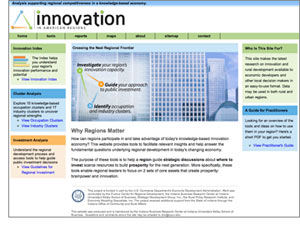 The notion that economic development is most effectively pursued via regional, cluster-based efforts is central to contemporary practice and EDA's strategic focus. So is the idea that regions can prosper by cultivating innovation-driven growth strategies.
The notion that economic development is most effectively pursued via regional, cluster-based efforts is central to contemporary practice and EDA's strategic focus. So is the idea that regions can prosper by cultivating innovation-driven growth strategies.
These concepts underlie a rich, online resource developed with EDA support for use by economic development practitioners (EDPs), civic leaders and policymakers throughout the nation. The Innovation in American Regions website provides detailed, county-level data and a set of practical analytical tools regional leaders can use to assess their regions' industry clusters, human capital and capacity to innovate.
It also presents a practical framework for regional leaders to collaborate to achieve mutual regional development goals. Using the results of the analytical tools, the framework helps guide the discussions of regional leaders in selecting sound strategies and in identifying the united efforts required to achieve common goals.
Four Tools for EDPs
The Innovation website is constantly updated with the latest economic and demographic data, which may be viewed or downloaded for pre-established or user-defined regions ranging in size from one to many counties. The user may view the data in tables and graphs and download it for further analysis. Comparisons across regions are easily managed.
Four types of tools designed with EDPs in mind are available on the site. These are:
- Industry clusters: regional groups of firms and industries with similar needs for technology, infrastructure, support services and labor. The site provides regional data for 17 industry clusters and several manufacturing sub-clusters.
- Occupation clusters: groupings of occupations requiring similar knowledge and skills. Understanding a region's occupation clusters is key to assessing how well its workforce matches the needs of its industries and the opportunity for growing existing or attracting new industries to capitalize on workforce capabilities. This tool provides county-level data on 15 occupation clusters.
- A newly developed Index of Innovation reflects a region's capacity to innovate and transform its economy. The Innovation Index helps assess a region's competitive advantages and weaknesses, and gauges how adept the region may be in growing new and emerging industries.
- A Regional Strategy and Investment Framework that uses the information gained from these three analytical tools to guide regional leaders toward a common regional vision, strategy and action.
The Innovation website also provides a practitioners guide with practical tips for using these tools, case study illustrations of the tools' application in four different regions, and hundreds of downloadable maps.
A Widely Used Resource
EDPs throughout the nation are finding Innovation in American Regions a useful resource to aid their work. This project and its tools received national awards of excellence from the Council on Community and Economic Research in 2010 and from the Association for University Business and Economic Research in 2009.
The project is the result of a collaborative effort by the Purdue Center for Regional Development, the Indiana Business Research Center at Indiana University, Strategic Development Group Inc., Economic Modeling Systems Inc., and the Rural Policy Research Institute. For more information about the project and for guidance in using the tools, go to www.statsamerica.org/innovation.
Highlight:
EDA Disaster Supplemental Appropriations
Since 2008, EDA has obligated a combined $500 million under the Supplemental Appropriations Disaster Relief and Second Supplemental Appropriations Disaster Relief Opportunities.
The $100 million and $400 million respective Disaster Appropriations were distributed to provide post-disaster economic recovery assistance to areas which a major disaster or emergency was declared.
Such assistance includes a $35 million grant to Cedar Rapids, Iowa to construct a new events center and arena in the downtown area that was devastated by the Midwest floods in 2008.
In Batesville, Arkansas, EDA invested $1.8 million to renovate a former machining facility in Batesville to convert the facility into a manufacturing plant, where job creation was vital to recover from severe storms in 2008.
The Town of Madawaska, Maine suffered damages from the May 2008 flooding of the St. John River. EDA invested $2 million to improve the town's wastewater system and prevent future flooding.
After being hit by Tropical Storm Fay in 2008, EDA invested $8.2 million in Gainesville, Florida for the construction of the Florida Innovation Hub, a technology incubator located near the campus of the University of Florida in Gainesville to serve the region's emerging and existing technology commercialization start-up companies.
On the west coast, regions have struggled with recovering after devastating wildfires. EDA invested $7.2 million in Anaheim, California to construct pedestrian walkways to link sites at a new hospital complex, aiding in the redevelopment of local industrial areas and creation of opportunities for new business development.
Not a stranger to natural disasters, the state of Wisconsin has been challenged with flooding in recent years. To spur high-skill, high-wage job creation, EDA invested $4.5 million in Madison, Wisconsin to advance biotechnology through the construction of a greenhouse for the Midwest BioLink Commercialization and Business Center to grow new businesses in urban and rural communities in the region.
U.S. Department of Commerce Completes First EDA/ITA Trade & Investment Mission
|
EDA and the International Trade Administration are leading a U.S. Trade & Investment Mission to HANNOVER MESSE from April 3-8, 2011. This fair combines 13 leading industrial technology trade shows all in one venue. It is an excellent opportunity for you to showcase your community as an attractive candidate for foreign direct investment and a valuable trading partner. More details about applying as a community delegate will be available shortly. Meanwhile, contact Laura Stierle to express interest or visit www.hannovermesse.de for more information.
|
For the first time ever, three bureaus within the U.S. Department of Commerce-the Economic Development Administration (EDA), the U.S. Commercial Service (USCS) and Commerce's Invest in America program–teamed up to promote U.S. exports and foreign direct investment (FDI) in the U.S. through an international trade and investment mission.
The U.S. Cleantech Trade & Investment Mission to Lyon, France and Brussels, Belgium took place from November 28-December 4, 2010. Co-led by U.S. Deputy Assistant Secretary of Commerce for Economic Development Brian McGowan and USCS Regional Director for Western Europe James Koloditch, the U.S. delegation consisted of 20 community delegates from across the U.S. seeking foreign direct investment and several companies looking to find new trading partners in support of President Obama's National Export Initiative (NEI).



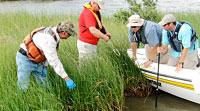
 The notion that economic development is most effectively pursued via regional, cluster-based efforts is central to contemporary practice and EDA's strategic focus. So is the idea that regions can prosper by cultivating innovation-driven growth strategies.
The notion that economic development is most effectively pursued via regional, cluster-based efforts is central to contemporary practice and EDA's strategic focus. So is the idea that regions can prosper by cultivating innovation-driven growth strategies.